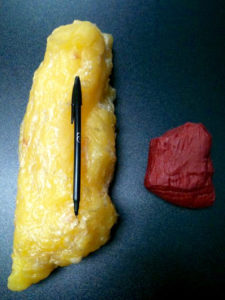Fat v/s Muscle
- There are about 600 muscles in the human body.
- The three main types of muscle include skeletal, smooth and cardiac.
- The brain, nerves and skeletal muscles work together to cause movement – this is collectively known as the neuromuscular system.
Different types of muscle
The three main types of muscle include:- Skeletal muscle – the specialised tissue that is attached to bones and allows movement. Together, skeletal muscles and bones are called the musculoskeletal system (also known as the locomotor system). Generally speaking, skeletal muscle is grouped into opposing pairs such as the biceps and triceps on the front and back of the upper arm. Skeletal muscles are under our conscious control, which is why they are also known as voluntary muscles. Another term is striated muscles, since the tissue looks striped when viewed under a microscope.
- Smooth muscle – located in various internal structures including the digestive tract, uterus and blood vessels such as arteries. Smooth muscle is arranged in layered sheets that contract in waves along the length of the structure. Another common term is involuntary muscle, since the motion of smooth muscle happens without our conscious awareness.
- Cardiac muscle – the muscle specific to the heart. The heart contracts and relaxes without our conscious awareness.
Make-up of muscle
Skeletal, smooth and cardiac muscle have very different functions, but they share the same basic composition. A muscle is made up of thousands of elastic fibres bundled tightly together. Each bundle is wrapped in a thin transparent membrane called a perimysium.An individual muscle fibre is made up of blocks of proteins called myofibrils, which contain a specialised protein (myoglobin) and molecules to provide the oxygen and energy required for muscle contraction. Each myofibril contains filaments that fold together when given the signal to contract. This shortens the length of the muscle fibre which, in turn, shortens the entire muscle if enough fibres are stimulated at the same time.
The neuromuscular system
The brain, nerves and skeletal muscles work together to cause movement. This is collectively known as the neuromuscular system. A typical muscle is serviced by anywhere between 50 and 200 (or more) branches of specialised nerve cells called motor neurones. These plug directly into the skeletal muscle. The tip of each branch is called a presynaptic terminal. The point of contact between the presynaptic terminal and the muscle is called the neuromuscular junction.To move a particular body part:
- The brain sends a message to the motor neurones.
- This triggers the release of the chemical acetylcholine from the presynaptic terminals.
- The muscle responds to acetylcholine by contracting.
Shapes of skeletal muscle
Generally speaking, skeletal muscles come in four main shapes, including:- Spindle – wide through the middle and tapering at both ends, such as the biceps on the front of the upper arm.
- Flat – like a sheet, such as the diaphragm that separates the chest from the abdominal cavity.
- Triangular – wider at the bottom, tapered at the top, such as the deltoid muscles of the shoulder.
- Circular – a ring-shape like a doughnut, such as the muscles that surround the mouth, the pupils and the anus. These are also known as sphincters.
Muscle disorders
Muscle disorders may cause weakness, pain, loss of movement and even paralysis. The range of problems that affect muscles are collectively known as myopathy. Common muscle problems include:- Injury or overuse, including sprains or strains, cramps, tendonitis and bruising
- Genetic problems, such as muscular dystrophy
- Inflammation, such as myositis
- Diseases of nerves that affect muscles, such as multiple sclerosis
- Conditions that cause muscle weakness, such as metabolic, endocrine or toxic disorders; for example, thyroid, and adrenal diseases, alcoholism, pesticide poisoning, medications (steroids, statins) and myasthenia gravis
- Cancers, such as soft tissue sarcoma.
Related: Importance of Fat
Fat vs. Muscle: Understanding The Truth Behind The Images
Fat vs. Muscle: The Body Image
Take one look at any weight loss picture, the before shows a man, probably in his 40’s with a large belly and looking overweight. The after, shows a sleeker version of the same man; the belly gone and his weight substantially less.
Despite the image of health, there is no guarantee that the slimmer man is any healthier.
This point is perfectly illustrated when you consider the image of two people who both weigh approximately 85kg; but one has 10% body fat, the other has 25%.
Muscle takes up less space, and hugs our body much more comfortably than fat, but a pound of muscle and a pound of fat, still weigh the same.
Fat vs. Muscle – The Real Difference
 A pound of fat weighs one pound. A pound of muscle weighs one pound! Muscle is more dense than fat.
A pound of fat weighs one pound. A pound of muscle weighs one pound! Muscle is more dense than fat.
Denser materials take up less space. This means a specific amount of muscle will occupy less physical space than the same quantity of fat.
It is this fact that makes the difference in the photos. The less body fat you have the more definition you will have round your muscles; creating a toned physique.
Despite what you may have heard, it is not possible to convert fat to muscle; or muscle to fat.
If you do not exercise your muscles will not grow and, because they are not being used, they will actually decrease in size. This will slow your metabolism and increase your fat stores.
In contrast exercise burns calories and; if you do not consume enough calories, the excess fat in your body is turned to energy to fuel your muscles; thus depleting your fat stores.
The result is just as in the image, fat has been burned and muscle built, but you should weigh the same; when muscle wins the battle of fat vs. muscle you look slimmer and fitter.
The only way that muscle can weigh more than fat is if you have a piece of muscle which takes up the same volume of space as a piece of fat. While this may be your eventual goal; it does not mean that muscle weighs more than fat. It just means you have a higher muscle content than you previously did and a lower fat content; which is healthy.
e lower your fat level is; but a body fat percentage calculation is really the safest way of knowing if you are really winning the fat vs. muscle battle.
Embracing Muscle
It doesn’t matter if you are looking to lose weight or build muscle, you should be aware that muscle is extremely beneficial to your body and your overall health:
- Muscle boosts your metabolism. Because it is denser than fat it requires more calories even when resting. The more muscle you have the more calories you will burn. Providing you stick to a sensible diet it will be difficult for you to gain fat.
- Improves Bone Mass. Muscle works to strengthen the bones it surrounds and supports; making them denser and reducing your risk of injury.
- This is an obvious benefit of muscle. If you complete compound exercises you will improve the strength of several muscles at the same time. The added benefit of this is an improvement in your core strength and balance.
- Winning the war of fat vs. muscle means you will have better body definition. This will inspire confidence in yourself in a wide variety of everyday situations. You may surprise yourself at what you can achieve.
- Strengthening Muscles. The stronger your muscles and the more calories they require the harder your body will need to work to maintain its resting level. This will result in improvements to your circulation, digestive system and the health of all your organs; reducing the risk of illness.
Fat vs. Muscle Additional Considerations
 Higher levels of fat have been shown to increase the likelihood of contracting type 2 diabetes, coronary issues, respiratory disorders and even some types of cancer.
Higher levels of fat have been shown to increase the likelihood of contracting type 2 diabetes, coronary issues, respiratory disorders and even some types of cancer.
Regardless of the fact that you look better when your body fat is lower, research shows you are likely to live longer and be healthier; this has to be the best advantage of allowing muscle to win the battle of fat vs. muscle.
The right diet and even basic physical exercise can reduce your body fat; add in a good workout routine, such as the Fit father 24-min workout and you won’t recognize yourself within just one month.
This is just the tip of the iceberg! The Fit father Project is here to support you on every step of your journey, beating fat and improving muscle to ensure that you can give your family the time and energy that you all deserve.





Comments
Post a Comment